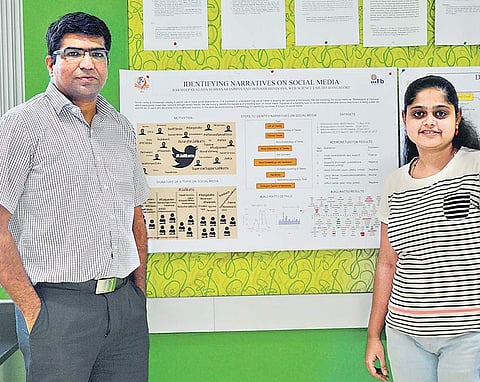

BENGALURU: One of the major charges against social media giant Facebook is that it represents an ‘echo chamber’, where one’s biases get strengthened. Facebook is presently at the centre of a debate about whether or not it did influence the US General Elections last year through fake news as a result of its echo chamber algorithms.
In such a situation, does having a web observatory to take note of macro trends on the internet and be aware of such phenomena, help? Researchers at the International Institute of Information Technology (IIIT-B), who have the country’s first web observatory — the Cogno-Web Observatory — certainly think so. A new centre for cognitive computing inaugurated at the institute on Thursday is aimed at helping this cause. A web observatory is a platform to make sense of the massive amounts of data on the internet and use it for social good.
Professor Srinath Srinivasa, dean, Research and Development, IIIT-B, says, “The objective of the observatory is social cognition and the impact of social media on it. The way we want to model this is that wherever and whenever there is a discourse on the net, such as on Aadhar or Jallikattu, we want to track different opinions expressed. Often, some opinions are compatible and others are contradictory. The combatable ones become a narrative and drive the trend,” he says. Giving the example of the recent Jallikattu issue, he says that while some regarded a ban on the practice an assault on Indian culture, others said it was animal abuse. “Through the observatory, we want to understand the narratives, primary arguments, primary drivers of the narratives and how to understand the social impact of this narrative,”
Researchers conducted a small study on Twitter, analysing one lakh tweets related to Jallikattu.
The researchers analysed the issue throughout January 2017 — the time the issue gained prominence due to review petitions on the ban of the sport. “We saw a number of trends during this time, for example, on January 2, the issue of Tamil culture was trending. As part of this larger issue, Rajnikanth supporting the sport became a another narrative within it. PETA getting involved added another narrative. An unconnected issue about Pepsi and Coca Cola companies using water from one region in Tamil Nadu, also became a side trend,” says Raksha PS, a PhD student involved in the project.
While the web observatory is still restricted to analysing Twitter trends, it will soon expand its operations to include other social media platforms and the internet as a whole. “At present, we are trying to create a user experience interface so that we can take a look at different parts of the virtual world in real time. We want people to be more aware of trends and not follow fake news blindly,” says Srinivas.There are around 16 web observatories in the world. These are in the UK, USA, Brazil and Singapore to name a few. A second web observatory is also set to come up at an institution in India.
New centre to help cognitive computing
The Centre of Excellence (CoE) for Cognitive Computing was inaugurated at the IIIT-B on Thursday. It was started by Mphasis, an IT services and solutions company in collaboration with the institute, and is set to help projects such as the web observatory. The aim is to solve problems related to education, enterprises and accessibility. The company announced an investment of `5 crore over the next three years. Technologies like accurate speech recognition, machine translation, video analytics and video synthesis have become a reality due to cognitive science and will also be focused on at CoE.